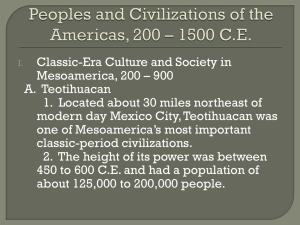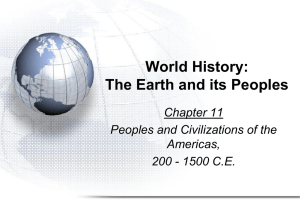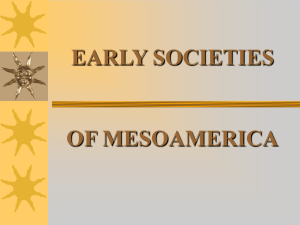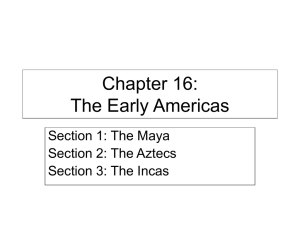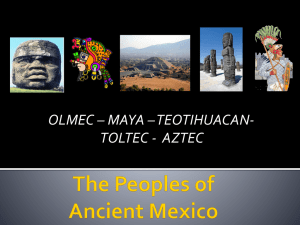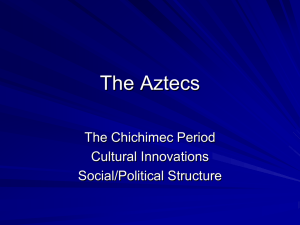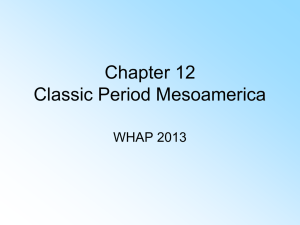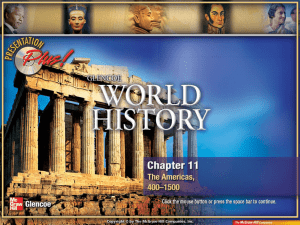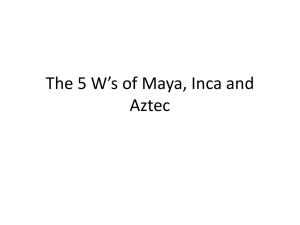Americas 600-1450 - Hinzman`s AP World History & Honors World
advertisement
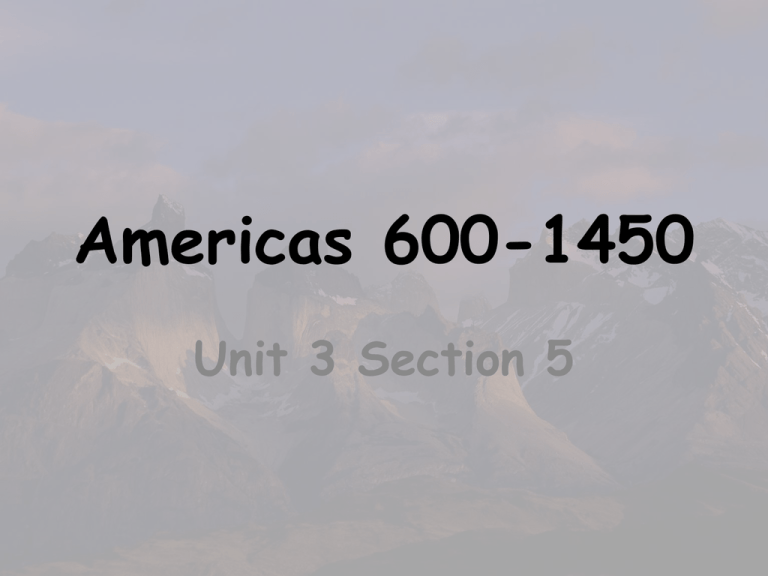
Americas 600-1450 Unit 3 Section 5 Classic-era Culture & Society in Mesoamerica: 600-900 • Although never under one central rule, the peoples of Mesoamerica developed similar religious, social, and cultural practices – Mesoamerica made strides in agriculture, astronomy, math, and political organization, building on the work of earlier civilizations like the Olmec • Population growth and the rise of long-distance trade led to the development of large urban centers with both religious and political significance – These cities had many architectural features, including pyramidstructures, designed for elaborate religious ceremonies – Thousand year old agricultural practices like terraced farming and irrigation continued to serve as the economic foundation for Mesoamerican society in the classic period; • The distinctive feature of the classic period in Mesoamerican society was not agricultural advances but rather social changes – These changes created a new political elite that control larger numbers of laborers and soldiers, – They grew in power, and extended political reach over larger areas of Mesoamerica • Two civilizations that exemplify the classic period are – Teotihuacan in Mexico – Maya in the Yucatán Peninsula Teotihuacan • Located just north of modern-day Mexico City, Teotihuacan we reached its zenith in 600 • The largest city in the Americas at the time, it had well over 100,000 inhabitants, perhaps as many as 200,000, and was one of the largest cities in the world as well • Teotihuacan was also a religious center that drew people from neighboring areas; – Priests were highly regarded and played a central role in the society • The elite status of priests was common in other Mesoamerican societies as well – The people of Teotihuacan were polytheistic, – The religious architecture focused on pyramid like structures dedicated to worshiping the sun, moon, and to God Quetzalcoatl, who was believed to be the source of agriculture and the arts – The people of Teotihuacan practice human sacrifice, which they considered a sacred duty necessary for the maintenance of human society Teotihuacan Economy • As the city grew, the governing elite developed the surrounding lands for agricultural production – In addition to irrigation and terraced farming on hillsides, the use of chinampas increased • Chinampas are man-made islands constructed out of the materials found in the lake environment • They allowed for agricultural production year-round, which provided a constant food supply for the growing population • A reliable food supply permitted specialization of labor in architecture as well as trade and art – – pottery and obsidian tools were key goods in long-distance trade The Fall of Teotihuacan • Other Mesoamerica societies had one central ruler – Historical evidence suggests that in Teotihuacan, an alliance of aristocratic families had political authority • Scholars also debate the role of Teotihuacan’s military; – archaeological evidence suggests that soldiers were used both to secure long-distance trade and to ensure that agricultural surpluses were used to the city’s benefit • Why Teotihuacan was destroyed is not clear, but there is evidence that the final decades were – Violent – The disagreements among the elites as well as the mishandling of resources lead to disorder and mass conflict – Resulting in the destruction of much of the city by 650 • Maya The Mayan civilization covered modern-day Guatemala, Honduras, Belize, and southern Mexico – The Maya were never politically unified but shared a single culture • Rulers of the various city states competed with one another for territorial supremacy – As in Teotihuacan, feeding the large populations in many urban centers necessitated planned agricultural strategies like terraced farming and irrigation – Strong Mayan cities featured elaborately decorated and colorful: – Religious palaces, – Pyramids, – Temples • All designed to express the political and religious authority of the King – Pyramids like Tikal in Guatemala, which rose above the trees, represented the access point to both the heavens of the underworld, and they were visible from large plazas where people gathered to witness the elaborate ceremonies of sacrifice and ritual that awed them – Amazingly, the Mayan other Amerindian societies were able to construct such incredible buildings • without the use of the wheel or metal tools; • stone tools and levers were the only technology used by the thousands of men and women who built the structures Religion and Social Structure • The role of religious ritual cannot be overstated – The elite had both secular and religious responsibilities and acted as intermediaries between the spirit world and material world • Both bloodletting sacrifice were considered essential to success in life and in war – Kings and other members of the elite led their soldiers in war, then their captives were sacrificed for the faith – The ruling families also had important religious and political roles and participated in ritual bloodletting ceremonies (Creepy details?? Yes, let’s discuss!) • Two kingdoms were known to have been ruled by women – though this was not the norm – Although less is known about the lower class women, scholars believe women • • • • played important religious roles in their homes, wove cloth, managed their households, directed family life Contributions • Some most important intellectual contributions of the Maya were in the areas of astronomical observation, hieroglyphic writing, and math, which included a concept of zero • These intellectual accomplishments allowed for the development of elaborate calendars that represent the best of Mesoamerica and culture • The Maya had three calendars: – One tracked a ritual cycle of 260 days – One was a solar calendar of 365 days – One was a Long Count calendar, • It began on a set date in 3114 B.C.E., the Mayan date of creation, and was continual Mayan Calendar Collapse • There is much speculation about how the classic period of the Maya ended – Although there were some urban centers which lasted far beyond the classic period, it is clear that between 800 and 900 many centers were destroyed or abandoned – Of the many reasons suggested, the strongest is that the combination of expansion and lack of agricultural productivity caused social tension that degenerated into warfare Post-classic Period 900-1500 • The postclassic period had continuities with the Mesoamerican classic period in – – – – – social structure, art, culture, (including religious practices) architecture, the role of cities • Population growth demanded the management of: • Agricultural resources • Military • Politics – Having control of these aspects and of the people became a priority for the two strongest societies of the post-classic period: • Toltecs • Aztecs Toltecs • Migrating people who eventually settled in central Mexico, the Toltecs built on many of the cultural practices of the people of Teotihuacan to create a sophisticated civilization – Their innovative contributions were mainly political and were based on military conquest that allow them to create a state reaching from north of Mexico City to Central America – The Toltec capital of Tula, though never as populous as Teotihuacan, was an elaborate architectural achievement in central Mexico – Toltec art depicted and glorified the militaristic aspects of its culture, including scenes of human sacrifice – Political organization was based on two kings who ruled together; at some point after 1000, a struggle between political elites resulted in the expulsion of one of the kings • This was the beginning of the end for the Toltecs, culminating in the destruction of the capital around 1156 when invaders from the North overtook it • As new peoples came into the Toltec region, they built on the ancient Mesoamerican traditions combined with the new Toltec military and political strategies – The strongest group that emerged from the migrating northern peoples in the centuries following the Toltecs were the Mexica, or Aztec people Aztecs • Organize by clan, the Mexica people, known as the Aztecs, were originally serfs and mercenaries for the more powerful groups in the area • As they were growing in power, the Aztecs moved to islands off the shore of Lake Texcoco – In 1325 they began building the two cities that would become the foundation of modern Mexico City, • Tenochtitlan • Tlatelolco Aztec hierarchy • Aztec society was based on military conquest and looked to the Toltec as models – Continual military success allowed the Aztecs to take good agricultural lands and establish a monarchy in the region • The monarch did not have absolute authority – Selected by a Council of aristocrats from among all the males of the ruling family, a new king had to complete a new round of military conquests to validate his role in the warring class • As these practices continued, social hierarchy tightened – The highest status was assigned to the warrior elite, » who enjoyed huge estates that relied on the labor of peasants, • who had little say in decision-making • Clan-based organization continue to be important in the twin capitals, – serving as a method for dividing agricultural labor and civic duties and also for creating military units Economy • Agricultural laborers provided the food for the Aztec’s large urban population of approximately 150,000 – The Aztecs, like the people of Teotihuacan before them, used the chinampa system to grow maize and various fruits and vegetables – They also built an impressive dike to separate freshwater from the salt water in the Lake Texcoco so that the land could be used for cultivation • Another vital resource for the Aztecs was the tribute system, which allowed the Aztecs to draw upon the labor and resources of conquered peoples – This tribute system provided a quarter of the food supplies for the Aztec Empire and also brought a variety of other practical items and luxury goods to the Aztecs – These tribute goods, along with the products from longdistance trade, diversified the rich markets of Tenochtitlan Social Stratification • By 1500, the population of the Twin Cities and the surrounding lakeshore areas was approximately half a million people • Aztec society was very stratified, and there was great division based on wealth – The rich ate, dressed, and lived well, – While commoners had a very basic diet and lived simply • Commoners could have only one spouse, while the elite could have a number – One distinct Aztec social group was the merchant class, • They had managed long-distance trade and also served as valuable sources of political and military information for the elites • Trade, based on barter instead of money or credit, was carried out without the use of beasts of burden or wheels, so the goods needed to be light enough to carry • Merchants grew wealthy as the empire grew, but they could not achieve the same status as the nobility, who watched them with a jealous eye Religion and Collapse http://www.youtube. com/watch?v=PrJLoR dLa20 – Aztec Priests • Like many other Mesoamerican cultures, religious rule and ceremony were key components of the King’s political success and authority • The Aztecs were polytheistic; their most famous religious cult centered on the worship of Huitzilopochtli, a hummingbird from the south – This God was first associated with war, then with the sun • Worship of the sun was a religious continuity throughout Mesoamerican history – The Aztecs believed that Huitzilopochtli needed human hearts to keep the sun shining, thereby sustaining life • As a result, the Temple of Tenochtitlan, devoted to Huitzilopochtli and Tlaloc, the rain god, was the site of large-scale rituals involving human sacrifice • This is another continuity from previous Mesoamerican societies, but the Aztecs expanded the ritual significantly, sacrificing war captives, criminals, slaves, and people who were given as tribute • Thousands were sacrificed each year; the very violent and public aspect of the ritual sent a clear message to subject peoples that they must submit to the authority of the Empire • The Aztec Empire continued until the arrival of the Conquistador Cortez, who captured Tenochtitlan in 1521 before going on to conquer the rest of Mexico The Peoples of North America • Around 900, the Southwestern desert and the Mississippi River Valley were two areas of high cultural achievement in North America – Building on economic benefits from long-distance trade, including the introduction of key staples from Mesoamerica like: • maize, • beans, • squash – The peoples of these areas developed societies with defined social structures and political roles unique to each region Hohokam • The Hohokam people lived in what is today Arizona – They were heavily influenced by mesoamerican cultures, particularly Mexican, as is reflected in the: • architecture, • pottery, • ceramics • They in turn influenced other societies in the region, and they built upon the agricultural technology and the artistic techniques of the Hohokam Anasazi • The second group that exemplifies southwestern desert culture is the Anasazi, a novel word used by archaeologists meaning “ancient ones” to refer to the various desert cultures located in what is now the southwestern United States – By 600, the Anasazi also had an economy based on maize, beans, and squash • They specialized in decorative pottery as well as cotton weaving – Underground buildings called kivas or community centers used for both religious ritual and craftwork – After 900, the Anasazi constructed larger multilevel buildings, which were prominent features in the larger towns Anasazi Decline • Chaco Canyon is the site of one of the largest Anasazi societies – Of the eight towns in the canyon, the largest was Pueblo Bonito, which contains a large kiva and other residential buildings • Archaeological research of its infrastructure suggests that Pueblo Bonito held religious or political dominance over the region – Merchants engaged in long-distance trade in northern Mexico • Because men hunted, cared for the irrigation works, and traded, they often had to be away • Women specialized in various crafts as well as helped with agriculture and other domestic duties – Chaco Canyon was abandoned in the 12th century because of drought, but the Anasazi continue to dwell in the larger region of the Southwest Mississippian Cultures 700-1500 • The first Amerindians along the Mississippi River were primarily hunter-gatherers – As maize, beans, and squash were introduced, most likely by intermediaries who had contacts with Mesoamerica, then more settled and urban lifestyle emerged – They began to build mounds for ceremonial and religious use as well as dwellings for Chiefs • The chief had both religious and political roles and also oversaw long-distance trade, which supplemented food supplies and brokered access to luxury goods • Urban communities developed as: – the food supply became more constant, – the bow and arrow were introduced, – trade expanded • With a larger population and larger towns, which served as centers for bartering, class distinctions increased Cahokia • Cahokia, the best example of the apogee of Mississippian culture, contained the largest mound – 100 feet high - in North America – In 1200, with about 20,000 inhabitants, Cahokia was equal in size to many post-classic Maya cities • Cahokia had political dominance over the surrounding agricultural territories and towns, and its long-distance trade, by canoe, brought in tools and goods used for rituals – Cahokia declined after 1250 because of climate changes and population increase • This combination put pressure on the food supply – Cahokia was eventually abandoned, but other mound cultures continued to thrive in the Southeast until the arrival of the Europeans Andean Civilizations • At the same time that highly sophisticated societies were developing in Mesoamerica, they were also developing in the Andean region – The ability to create and maintain complex civilizations in the difficult environment of the Andes Mountains is amazing, and geography played a huge role in how those communities and then larger states were constructed – Andean peoples had to cope with three ecological zones: • The high altitudes and harsh weather of the mountainous zone • The arid zone of the coastal region by the Pacific Ocean • The hot humid Amazonian tropical zone – Sustaining life in the zones required various technologies, among them • • • • • terraced hillside farming, irrigation systems, road networks for long-distance exchange, accurate calendars, plant domestication – In addition, animals like llama and the alpaca or used as beasts of burden as well as sources of meat and wool – Khipus, knotted colored cords that could be used for record-keeping, were a unique technology that served as an important administrative tools as well Ayllu & Mit’a • Productive and efficient use of human labor was also essential in managing the environment – The basic unit that allowed for such labor was the ayllu, a clan that worked a specific area of land • Families within the ayllu were expected to work together on everyday jobs • They were also obligated to supply food and labor to the chief of the ayllu – When larger political organization was placed under the authority of the hereditary king, the mit’a system was created • Every ayllu rotated in and out of the mit’a system, – This required the ayllu to contribute a specific number of workers every year to do maintenance work for the state – » building projects, » road maintenance, » textile production, » irrigation work – They also cared for the birds and fields that belong to the royal family, the religious elite, and the aristocracy – The mit’a system was used by Andean societies for more than 1000 years Vertical Integration • Because so many smaller ecological zones existed in the Andean region and each zone produced different goods that were necessary resources, vertical integration was necessary – Vertical integration is a term coined by historians to describe the practices of the Andean peoples who purposely exchanged goods from these differing ecological zones in order to have everything they needed • Colonists were sent out by different ayllus in order to gain access to these goods • They were also to ensure the economic benefit the exchange provided was returned back to the original clan territory Moche • By 600, the Moche were dominant in the northern coastal area of Peru – They relied on the mit’a system to supply laborers for irrigation – They also depended on the llama and alpaca for trade • The wool of these animals allowed the Moche to create a strong textile industry, and women of all classes had special roles as weavers – The Moche excelled in ceramic work, creating pottery that included vases with detailed • portraits, • religious imagery, • depictions of daily life – The Moche also developed metal tools for agriculture and military use – A rigid social structure allowed for the clear division of labor, and religion was a central component of society • Priests and military leaders held political control, and their clothing and elaborate gold jewelry demonstrated their wealth and set them apart • The bulk of people, both men and women, focused on agricultural production and other labor requirements • Because we have no written records about the Moche, archaeological evidence alone provides the clues for their decline – Repeated natural disasters seem to be the cause for both the weakening of the economy and the authority of religious and political leaders, who drew their power from the belief that they could control the natural world Tiwanaku & Wari • The peoples of Tiwanaku and Wari, Moche contemporaries, lived in the Highlands – Tiwanaku was an urban center located in modern Bolivia next to Lake Titicaca – Once drained, the marshes around the lake provided thousands of acres of land – The lake fish provided protein, as did llamas, which were also used for transport and long-distance trade that brought in a variety of foodstuffs and neck or cultural goods • Tiwanaku had a grand ceremonial and religious center built out of stone, which was cut and moved many miles to build pyramids and other buildings as well as huge human statues – With limited tools, the labor used to complete the projects was extensive, making the achievement all the more impressive and demonstrating the ability of the people of Tiwanaku to manage a large labor system • Military conquest allowed the Tiwanaku people to establish colonies to ensure food supplies from the different ecological zones of the Andean region – Wari was larger than Tiwanaku, but the relationship between the two centers is unclear even though their peoples had some cultural similarities • Wari contained a walled city that included a huge temple as well as urban and suburban housing – By 1000 both the Wari and Tiwanaku had declined significantly • The stage was set for the Inca, the next great Andean society The Inca • The Inca created an amazing empire that stretched up and down the coast of South America – It had more than 6 million people under its control by 1525 – Their rise to power began in the 1430s when strong political leaders joined together and began an age of military conquest Inca • Many of the Andean traditions were fundamental to the life of the Incas – They were pastoralists who depended on the llama and the alpaca for food, clothing, and transportation • Caring for these animals was the job of both men and women and was a representation of the obligations of the gods and the ruler to the people – The mit’a system continued as the fundamental building block of the Empire – Each ayllu contributed 1/7 of its males for labor to create a food surplus for the elderly and sick – Laborers also built 13,000 miles of road, which linked the Empire economically and militarily Incan Society http://www.youtube.c om/watch?v=vAQmkS 7x6ZE - Pachacuti • In order to rule effectively, local chiefs were kept in place and handled local administrative duties and judicial matters – However, to minimize the risk of rebellion, heirs of defeated territories had to live at the Incan royal court, and images of local deities also had to be brought to Cuzco, the center of government • Inca society was highly stratified; the imperial elite of Cuzco and other urban centers could live a life very removed from the lower class – so much so that a commoner who looked the ruler in the face could be executed – To cement its authority, the royal family also claimed a divine link to the Sun, one of the primary gods worshiped by the Inca – Finally, all those who made up the royal bureaucracy had to be kinsmen • As in other Amerindian societies, religious ritual reaffirmed the power of the king • Like the Aztec kings, each new Incan king was expected to extend the empire through conquest Contributions • Cuzco was located near the center of the empire and was connected to other cities by the intricate network of Incan roads – Although Cuzco was never as populated as the Aztecs’ Tenochtitlan, it was a true Imperial city, with massive, detailed stonework as well as elaborate palaces and temples reflecting each ruler’s glory • The Temple of the Sun was the most glorious, with gold adorning its inner walls • Sacrifices to the Sun included animals, textiles, and, in frequently, humans • As in Mesoamerica, calendars based on astronomical observations were important for religious ritual • Inca textile weaving and metallurgy – continuities handed down from earlier Andean societies – surpass the Mesoamericans’ – Copper and bronze weapons were decorated with gold and silver • Khipus continued to be used for communication and recordkeeping and were especially important because the Inca multiplied their production and economic output with the conquest of peoples in different environments Collapse • The Inca ruled for a century, but in 1525, when the Incan ruler Huayna Capac died, the Empire spiraled into a bloody conflict over which son should succeed him – The conflict escalated into a civil war that allowed disgruntled conquered peoples of varying ethnicities and regions to rise up as well • This was the state of the Inca empire when the Europeans arrived in the Andean region and the beginning of the 16th century
